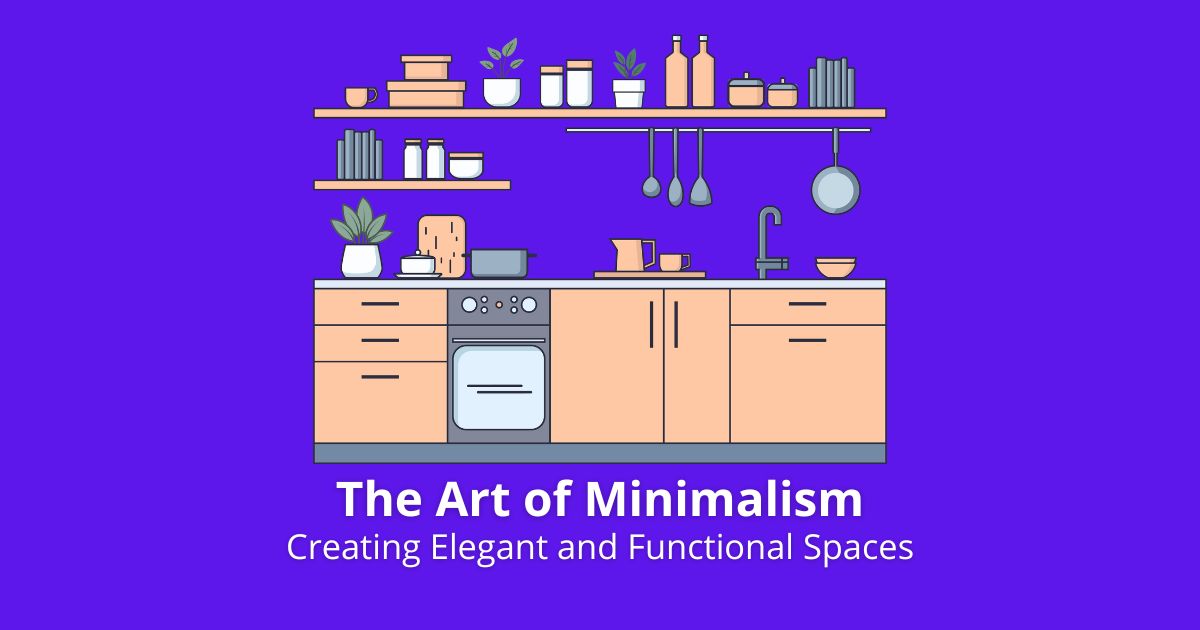Minimalism is more than a mere design trend; it is a lifestyle choice that emphasizes simplicity and functionality. This design philosophy is characterized by the elimination of unnecessary elements, focusing instead on the essentials that provide purpose and meaning.

Minimalism transforms spaces into elegant, serene environments that promote clarity and peace. Here, the principles and benefits of minimalism, along with practical steps for creating elegant and functional minimalist spaces, are explored in depth.
Principles of Minimalist Design
1. Simplicity:
Minimalist design thrives on simplicity. This principle involves the reduction of elements to their basic forms and functions. Clean lines, uncluttered spaces, and a monochromatic palette are hallmarks of simplicity in minimalism. By stripping away excess, spaces are left with only what is essential, creating a calming and ordered environment.
2. Functionality:
Every item in a minimalist space must serve a purpose. This principle ensures that each piece of furniture, décor, and appliance is chosen for its utility as well as its aesthetic contribution. The functionality principle eliminates clutter and makes everyday living more efficient and enjoyable.
3. Quality over Quantity:
Minimalism values the quality of items over the number of possessions. This means investing in well-crafted, durable items that will stand the test of time. High-quality materials and craftsmanship are essential to creating spaces that are both elegant and functional.
4. Open Spaces:
Open, airy spaces are a fundamental aspect of minimalist design. This involves not only the physical layout but also the visual perception of space. Using furniture with legs, incorporating large windows, and employing light colors can enhance the feeling of openness and freedom. This applies very well for those looking for kitchen remodeling ideas.
5. Neutral Colors:
A minimalist color palette typically consists of neutral tones such as whites, grays, and beiges. These colors create a harmonious and tranquil atmosphere. While accent colors can be used, they are often kept to a minimum to maintain the simplicity and cohesion of the design.
Benefits of Minimalist Design
-
Reduced Stress: Clutter can be a significant source of stress and anxiety. Minimalist spaces, free of unnecessary items, promote a sense of calm and order. This serene environment allows for better focus and relaxation.
-
Enhanced Functionality: With an emphasis on functionality, minimalist spaces are designed to be highly practical. This ensures that everyday tasks are streamlined and efficient, contributing to a more organized and productive lifestyle.
-
Aesthetic Appeal: The clean, uncluttered look of minimalist design has a timeless appeal. The focus on quality materials and simple forms results in spaces that are elegant and sophisticated.
-
Sustainability: Minimalism encourages the use of fewer, better-quality items, which aligns with sustainable living practices. By choosing durable and versatile pieces, waste is reduced, and resources are conserved.
-
Easy Maintenance: Minimalist spaces are easier to clean and maintain. Fewer items mean less dusting and cleaning, making it simpler to keep the space tidy and orderly.
Creating Elegant and Functional Minimalist Spaces
The first step in adopting a minimalist approach is to declutter. Evaluate each item in the space and ask whether it serves a purpose or brings joy. Items that do not meet these criteria should be removed. This process helps to create a blank canvas for designing a minimalist space.
Furniture that serves multiple purposes is ideal for minimalist spaces. Examples include a sofa bed, a coffee table with storage, or a dining table that doubles as a workspace. Multifunctional pieces reduce the need for additional furniture, keeping the space uncluttered. Invest in high-quality furniture and décor in kitchen layouts. These items should be durable, timeless, and aesthetically pleasing. Quality items not only look better but also last longer, aligning with the minimalist principle of quality over quantity.
Negative space, or the empty space around and between objects, is crucial in minimalist design. It allows each item to stand out and breathe, enhancing the overall aesthetic. Be mindful of leaving ample negative space to avoid overcrowding.
Stick to a neutral color palette to create a cohesive and serene environment. While it is possible to incorporate accent colors, they should be used sparingly and thoughtfully to maintain the minimalist aesthetic. Natural materials like wood, stone, and plants add warmth and texture to minimalist spaces. These elements connect the interior to the natural world, creating a more inviting and harmonious environment.
Choose furniture and décor with clean lines and simple forms. Avoid ornate details and excessive embellishments. The simplicity of the forms contributes to the overall elegance and functionality of the space.
While minimalist design often relies on a neutral color palette, texture can add depth and interest. Incorporate a variety of textures through fabrics, rugs, and finishes to create a more dynamic and engaging space.
Good lighting is essential in minimalist spaces. Natural light should be maximized through large windows and light, sheer curtains. Artificial lighting should be simple yet effective, using fixtures that complement the minimalist aesthetic. Consider a mix of ambient, task, and accent lighting to create a balanced and functional lighting scheme.
Minimalism does not mean eliminating all personal touches. Select a few meaningful items, such as artwork, photographs, or heirlooms, to add character and personality to the space. These items should be displayed thoughtfully to avoid clutter.
Conclusion
The art of minimalism lies in creating spaces that are both elegant and functional through simplicity, functionality, and quality. By embracing minimalist principles, individuals can transform their environments into serene, efficient, and aesthetically pleasing spaces.
Minimalist design offers numerous benefits, from reducing stress and enhancing functionality to promoting sustainability and easy maintenance. By following practical steps such as decluttering, choosing multifunctional furniture, and incorporating natural elements, anyone can create a minimalist space that is a true reflection of elegance and practicality.